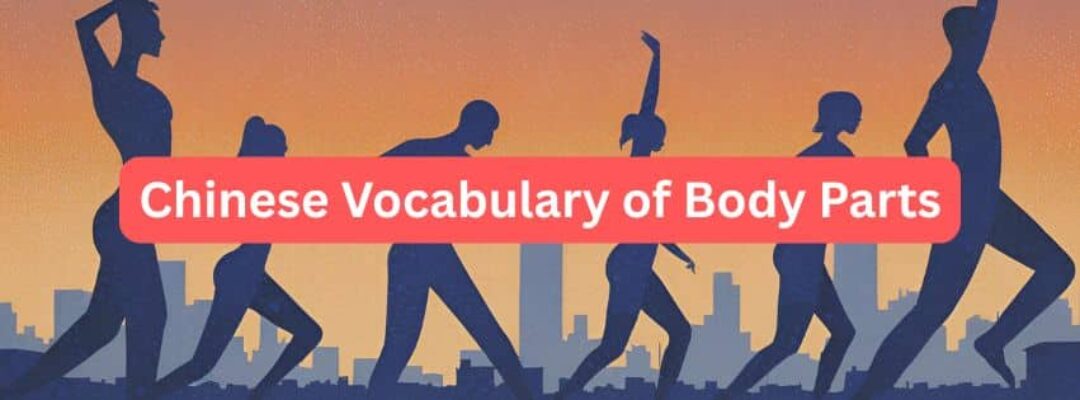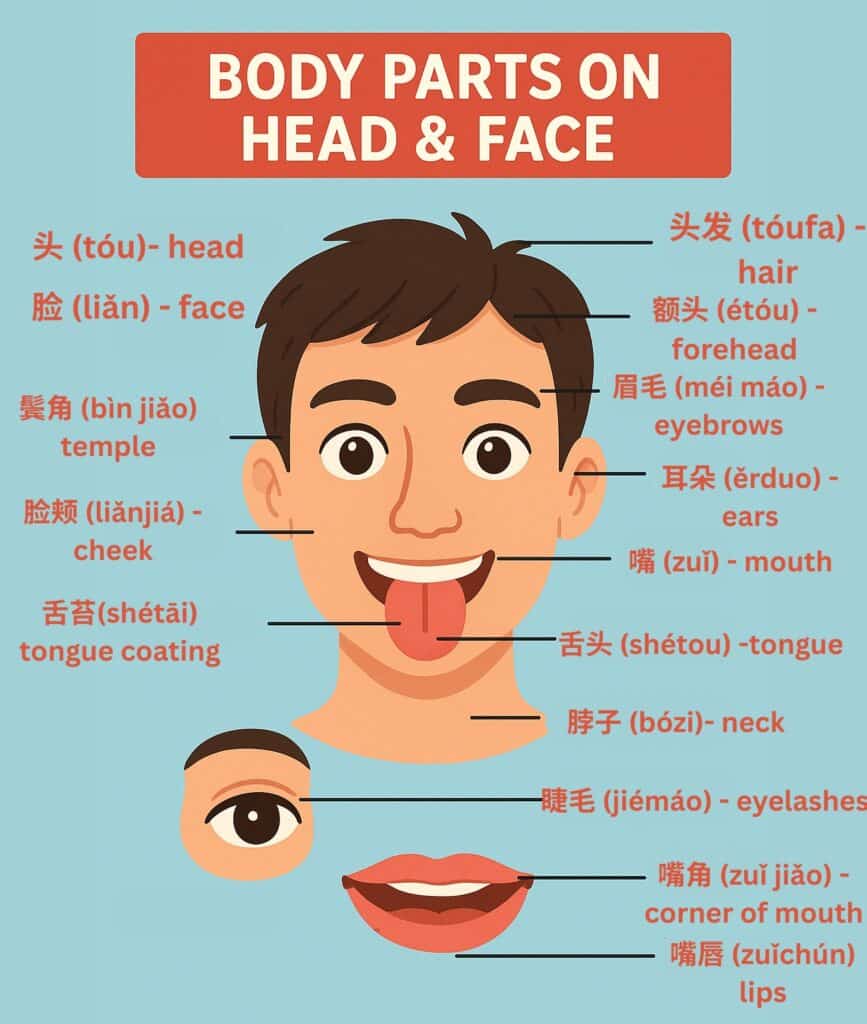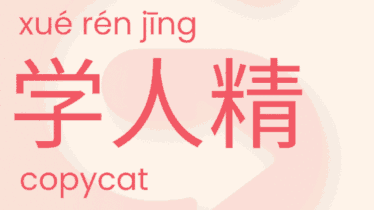Essential Chinese Body Part Vocabulary
Learning body parts in Chinese isn’t just practical—it’s fundamental to describing health issues, giving directions, or simply expanding your everyday vocabulary. As a Chinese language school who’s taught Mandarin for years, we’ve seen how mastering these terms creates a strong foundation for language learners.
Why Learn Body Part Vocabulary in Chinese?
Whether you’re describing symptoms to a doctor in Beijing or following a Tai Chi instructor’s movements, knowing body-related terms will make your Chinese journey much smoother. Plus, these words appear frequently in idioms and everyday expressions!
Essential Chinese Body Parts Vocabulary List
Head Region (头部区域)
The Chinese word for “head” is 头 (tóu), which forms the base for many related terms. Your face (脸 liǎn) includes several important features:
- 眼睛 (yǎnjing) – eyes
- 鼻子 (bízi) – nose
- 嘴 (zuǐ) – mouth
- 耳朵 (ěrduo) – ears
Torso and Core (躯干)
Moving down to the body’s center:
- 脖子 (bózi) – neck
- 肩膀 (jiānbǎng) – shoulders
- 胸部 (xiōngbù) – chest
- 背部 (bèibù) – back
- 腰 (yāo) – waist
- 肚子 (dùzi) – belly/stomach
Arms and Hands (手臂和手)
You’ll need these terms for everyday activities:
- 手臂 (shǒubì) – arm (formal)
- 胳膊 (gēbo) – arm (colloquial)
- 肘部 (zhǒubù) – elbow
- 手腕 (shǒuwàn) – wrist
- 手 (shǒu) – hand
- 手指 (shǒuzhǐ) – finger
- 拇指 (mǔzhǐ) – thumb
Legs and Feet (腿和脚)
Essential for movement vocabulary:
- 腿 (tuǐ) – leg
- 大腿 (dàtuǐ) – thigh
- 膝盖 (xīgài) – knee
- 小腿 (xiǎotuǐ) – calf
- 脚踝 (jiǎohuái) – ankle
- 脚 (jiǎo) – foot
- 脚趾 (jiǎozhǐ) – toe
Internal Organs and Systems
While less commonly used in beginner conversations, these terms become important as your proficiency grows:
- 心脏 (xīnzàng) – heart
- 肺 (fèi) – lungs
- 肝脏 (gānzàng) – liver
- 血液 (xuèyè) – blood
- 骨头 (gǔtou) – bone
Essential Chinese Body Part Vocabulary Table
| Chinese | Pinyin | English |
|---|---|---|
| Head & Face | ||
| 头 | tóu | head |
| 脸 | liǎn | face |
| 眼睛 | yǎnjing | eyes |
| 鼻子 | bízi | nose |
| 嘴 | zuǐ | mouth |
| 嘴唇 | zuǐchún | lips |
| 牙齿 | yáchǐ | teeth |
| 舌头 | shétou | tongue |
| 下巴 | xiàba | chin |
| 脸颊 | liǎnjiá | cheek |
| 额头 | étou | forehead |
| 眉毛 | méimao | eyebrows |
| 睫毛 | jiémao | eyelashes |
| 耳朵 | ěrduo | ears |
| 头发 | tóufa | hair |
| Torso & Upper Body | ||
| 脖子 | bózi | neck |
| 肩膀 | jiānbǎng | shoulder |
| 胸部 | xiōngbù | chest |
| 背部 | bèibù | back |
| 腰 | yāo | waist |
| 肚子 | dùzi | belly/stomach |
| 肚脐 | dùqí | belly button/navel |
| Arms & Hands | ||
| 手臂 | shǒubì | arm |
| 胳膊 | gēbo | arm (colloquial) |
| 肘部 | zhǒubù | elbow |
| 手腕 | shǒuwàn | wrist |
| 手 | shǒu | hand |
| 手指 | shǒuzhǐ | finger |
| 拇指 | mǔzhǐ | thumb |
| 指甲 | zhǐjia | fingernail |
| 手掌 | shǒuzhǎng | palm |
| Legs & Feet | ||
| 腿 | tuǐ | leg |
| 大腿 | dàtuǐ | thigh |
| 膝盖 | xīgài | knee |
| 小腿 | xiǎotuǐ | calf |
| 脚踝 | jiǎohuái | ankle |
| 脚 | jiǎo | foot |
| 脚趾 | jiǎozhǐ | toe |
| 脚后跟 | jiǎohòugēn | heel |
| Internal Organs & Other Body Parts | ||
| 心脏 | xīnzàng | heart |
| 肺 | fèi | lungs |
| 肝脏 | gānzàng | liver |
| 肾脏 | shènzàng | kidney |
| 血液 | xuèyè | blood |
| 骨头 | gǔtou | bone |
| 皮肤 | pífū | skin |
| 肌肉 | jīròu | muscle |
| 神经 | shénjīng | nerve |
Learning Tips
Remember that memorizing these terms works best when you practice them in context. Try labeling objects around your house, describing what hurts when you’re feeling unwell, or using body parts in simple sentences.
Want to take your Chinese to the next level with personalized guidance? Consider exploring what GoEast Mandarin free trial class—our teachers can help you perfect your pronunciation and use these terms naturally in conversation.





